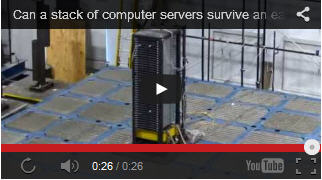Video: Can a Stack of Computer Servers Survive an Earthquake?

Credit: Cory Nealon, University at Buffalo The rack of servers shook, but did not fall, during a simulation that mimicked 80 percent of the force of 1994's Northridge earthquake.
How do you prevent an earthquake from destroying expensive computer systems?
That’s the question earthquake engineer Claudia Marin-Artieda, PhD, associate professor of civil engineering at Howard University, aims to answer through a series of experiments conducted at the University at Buffalo.
“The loss of functionality of essential equipment and components can have a disastrous impact. We can limit these sorts of equipment losses by improving their seismic performance,” Marin-Artieda said.
• Here is a video showing one of the tests, which mimics 80 percent of the force of 1994's Northridge earthquake: http://bit.ly/1lyO1aZ.
In buildings such as data centers, power plants and hospitals, it could be catastrophic to have highly-sensitive equipment swinging, rocking, falling and generally bashing into things.
In high-seismic regions, new facilities often are engineered with passive protective systems that provide overall seismic protection. But often, existing facilities are conventional fixed-base buildings in which seismic demands on sensitive equipment located within are significantly amplified. In such buildings, sensitive equipment needs to be secured from these damaging earthquake effects, Marin-Artieda said.
The stiffer the building, the greater the magnification of seismic effects, she added.
“It is like when you are riding a rollercoaster,” she said. “If your body is relaxed, you don’t feel strong inertial effects. But if you hold your body rigid, you’ll feel the inertial effects much more, and you’ll get knocked about in the car.”
The experiments were conducted this month at the University at Buffalo’s Network for Earthquake Engineering Simulation (NEES), a shared network of laboratories based at Purdue University.
Marin-Artieda and her team used different devices for supporting 40 computer servers donated by Yahoo Labs. The researchers attached the servers to a frame in multiple configurations on seismically isolated platforms. They then subjected the frame to a variety of three-directional ground motions with the servers in partial operation to monitor how they react to an earthquake simulation.
Preliminary work confirmed, among other things, that globally and locally installed seismic isolation and damping systems can significantly reduce damage to computer systems and other electronic equipment.
Base isolation is a technique that sets objects atop an energy-absorbing base; damping employs energy-absorbing devices within the object to be protected from an earthquake’s damaging effects.
Marin-Artieda plans to expand the research by developing a framework for analysis, design and implementation of the protective measures.
The research is funded by the National Science Foundation. In addition to Yahoo Labs, industry partners include Seismic Foundation Control Inc., The VMC Group, Minus K Technology Inc., Base Isolation of Alaska, and Roush Industries Inc. All provided in-kind materials for the experiments.
Contact:
Marti LaChance, lachance@purdue.edu
Purdue University
765-496-3014
Cory Nealon, cmnealon@buffalo.edu
University at Buffalo
716-645-4614
Media Contact
All latest news from the category: Earth Sciences
Earth Sciences (also referred to as Geosciences), which deals with basic issues surrounding our planet, plays a vital role in the area of energy and raw materials supply.
Earth Sciences comprises subjects such as geology, geography, geological informatics, paleontology, mineralogy, petrography, crystallography, geophysics, geodesy, glaciology, cartography, photogrammetry, meteorology and seismology, early-warning systems, earthquake research and polar research.
Newest articles

Security vulnerability in browser interface
… allows computer access via graphics card. Researchers at Graz University of Technology were successful with three different side-channel attacks on graphics cards via the WebGPU browser interface. The attacks…

A closer look at mechanochemistry
Ferdi Schüth and his team at the Max Planck Institut für Kohlenforschung in Mülheim/Germany have been studying the phenomena of mechanochemistry for several years. But what actually happens at the…

Severe Vulnerabilities Discovered in Software to Protect Internet Routing
A research team from the National Research Center for Applied Cybersecurity ATHENE led by Prof. Dr. Haya Schulmann has uncovered 18 vulnerabilities in crucial software components of Resource Public Key…




















